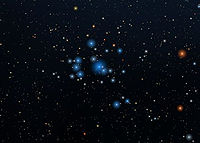
IC 2602
Encyclopedia

Index Catalogue
The Index Catalogue —also known as the Index Catalogue of Nebulae, the Index Catalogue of Nebulae and Clusters of Stars, IC I, or IC II— is a catalogue of galaxies, nebulae and star clusters that serves as a supplement to the New General Catalogue...
2602 (and Caldwell
Caldwell catalogue
The Caldwell Catalogue is an astronomical catalog of 109 bright star clusters, nebulae, and galaxies for observation by amateur astronomers. The list was compiled by Sir Patrick Caldwell-Moore, better known as Patrick Moore, as a complement to the Messier Catalogue.The Messier Catalogue is used...
102) (also known as the Theta Carinae
Theta Carinae
Theta Carinae is a star in the constellation Carina. It is the brightest star in the open star cluster IC 2602, and it marks the northeastern end of the Diamond Cross asterism....
Cluster or Southern Pleiades
Pleiades (star cluster)
In astronomy, the Pleiades, or Seven Sisters , is an open star cluster containing middle-aged hot B-type stars located in the constellation of Taurus. It is among the nearest star clusters to Earth and is the cluster most obvious to the naked eye in the night sky...
) is an open cluster
Open cluster
An open cluster is a group of up to a few thousand stars that were formed from the same giant molecular cloud and have roughly the same age. More than 1,100 open clusters have been discovered within the Milky Way Galaxy, and many more are thought to exist...
in the constellation
Constellation
In modern astronomy, a constellation is an internationally defined area of the celestial sphere. These areas are grouped around asterisms, patterns formed by prominent stars within apparent proximity to one another on Earth's night sky....
Carina
Carina (constellation)
Carina is a constellation in the southern sky. Its name is Latin for the keel of a ship, and it was formerly part of the larger constellation of Argo Navis until that constellation was divided in three.-Stars:...
. It was discovered by Abbe Lacaille in 1751 from South Africa
South Africa
The Republic of South Africa is a country in southern Africa. Located at the southern tip of Africa, it is divided into nine provinces, with of coastline on the Atlantic and Indian oceans...
. The cluster is at a distance of about 479 light-year
Light-year
A light-year, also light year or lightyear is a unit of length, equal to just under 10 trillion kilometres...
s away from Earth
Earth
Earth is the third planet from the Sun, and the densest and fifth-largest of the eight planets in the Solar System. It is also the largest of the Solar System's four terrestrial planets...
and can be seen with the naked eye
Naked eye
The naked eye is a figure of speech referring to human visual perception unaided by a magnifying or light-collecting optical device, such as a telescope or microscope. Vision corrected to normal acuity using corrective lenses is considered "naked"...
. The Southern Pleiades (IC 2602) has an overall apparent magnitude
Apparent magnitude
The apparent magnitude of a celestial body is a measure of its brightness as seen by an observer on Earth, adjusted to the value it would have in the absence of the atmosphere...
of 1.9, which is 70% fainter than the Taurean Pleiades
Pleiades (star cluster)
In astronomy, the Pleiades, or Seven Sisters , is an open star cluster containing middle-aged hot B-type stars located in the constellation of Taurus. It is among the nearest star clusters to Earth and is the cluster most obvious to the naked eye in the night sky...
, and contains about 60 stars. Theta Carinae
Theta Carinae
Theta Carinae is a star in the constellation Carina. It is the brightest star in the open star cluster IC 2602, and it marks the northeastern end of the Diamond Cross asterism....
, the brightest star
Star
A star is a massive, luminous sphere of plasma held together by gravity. At the end of its lifetime, a star can also contain a proportion of degenerate matter. The nearest star to Earth is the Sun, which is the source of most of the energy on Earth...
within the open cluster, is a third-magnitude star with an apparent magnitude of +2.74. All the other stars within the cluster are of the fifth magnitude and fainter. Like its northern counterpart in Taurus
Taurus (constellation)
Taurus is one of the constellations of the zodiac. Its name is a Latin word meaning 'bull', and its astrological symbol is a stylized bull's head:...
, the Southern Pleiades spans a sizeable area of sky, approximately 50 arcminutes, so it is best viewed with large binoculars or telescope with a wide-angle eyepiece. The cluster is thought to have the same age as the open cluster
Open cluster
An open cluster is a group of up to a few thousand stars that were formed from the same giant molecular cloud and have roughly the same age. More than 1,100 open clusters have been discovered within the Milky Way Galaxy, and many more are thought to exist...
IC 2391
IC 2391
IC 2391 is an open cluster in the constellation Vela. It has been purported to be first described by the Persian astronomer Al Sufi in about 964. It was also found by Abbe Lacaille and has been cataloged as Lac II 5. The cluster is at a distance of about 500 light-years away from Earth and can be...
, which has a lithium depletion boundary
Lithium depletion boundary
The lithium depletion boundary technique is a method proposed for dating open clusters based on a determination of the lithium abundances of a cluster's stars whose masses are at about the hydrogen burning mass limit....
age of 50 million years old.
External links
See also
- Theta CarinaeTheta CarinaeTheta Carinae is a star in the constellation Carina. It is the brightest star in the open star cluster IC 2602, and it marks the northeastern end of the Diamond Cross asterism....
star

